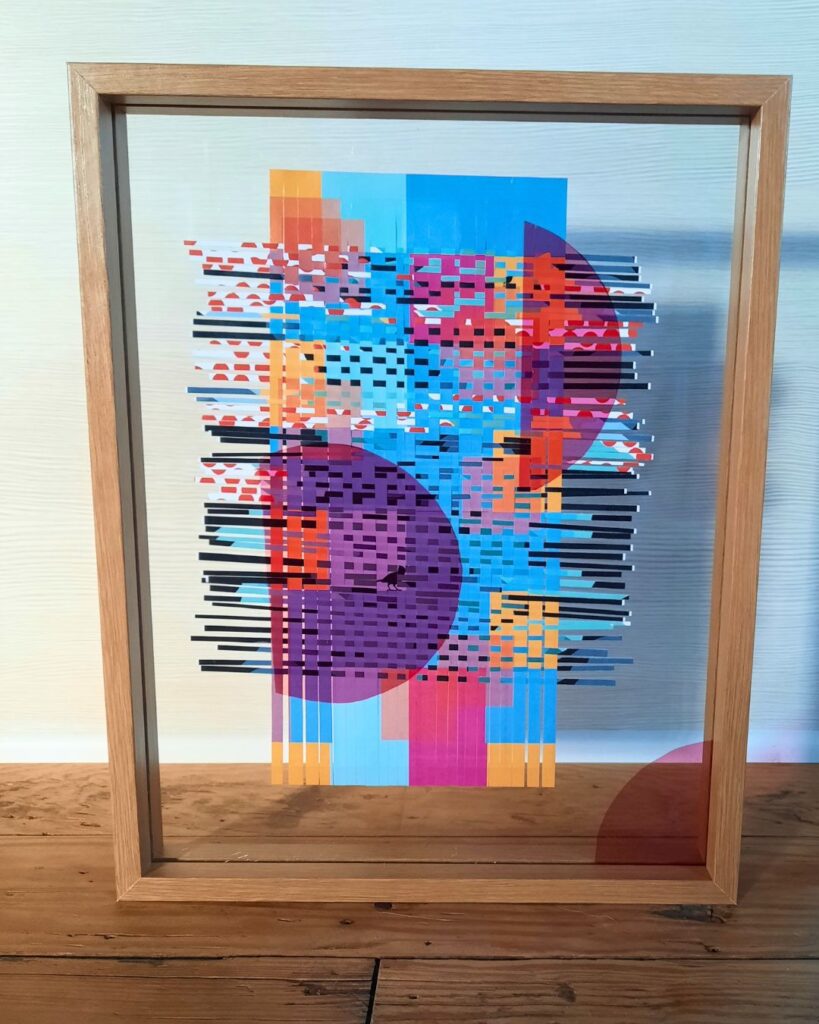The Art of Paper Weaving: Exploring Process
My creative process tends to swing in extremes, and I make nothing or EVERYTHING with very little in between. I’m unsure if this is good or bad, but this is my process, so I’ve learned to embrace it and buckle up for the fast and furious ride once I get going.
I was going to make 50 mini weavings, one a day, as an end-of-the-day practice; I knew that this would never happen from the moment I said I would do it, but I said it anyway. Would I make 50 mini weavings, FOR SURE, would I make just one a day? NEVER.

The 50 mini weavings set the creative muses loose, which led me to determine I also needed to make VERY LARGE WEAVINGS and a book (The Art of Paper Weaving.. coming soon) about paper weaving so that you could enjoy the creative practice but with a bit less wild abandon.
Once the custom wrapping paper I designed arrived, I was ready to go, or so I thought. I had yet to put a plan together about approaching such a large project.
To protect the in-progress work from Velo, our adventurous cat, I decided to hang it on the wall for safekeeping. I grabbed a large extra piece of cabinetry, left over from our kitchen remodel, propped the 96″ piece against the wall, and then adhered to the corkboard strip I conventily purchased over a year ago but never used.
Next, I grabbed a ladder and two oversized push pins and hung the work. It looked great and appeared secure, and with that, I headed to bed, only to discover it crumbled on the floor the following day, as the tacky strips couldn’t withstand the weight and the humidity. Perhaps this is a good argument for turning the AC on.
After rescuing the work, I continued to weave, making a final row of over, under, over, and under, thinking about what the thread count of this piece would be if it were fabric. Did you know that thread count means how many threads there are per inch, and the more threads, the tighter the weave and the smoother and stronger the surface? If I followed traditional weaving practices in my textile work, I could tell you how many ends there are in each scarf, but I can’t because I never count; I only feel.
Finally, I flipped the work over, and magic!
When weaving, I only look at one side, knowing something different is appearing on the other. Sometimes, it ends up being as beautiful and exciting as I first intended on the front; other times, it’s not interesting. This time, I’d expected it to be rather blah; it was only white anyway, but it wasn’t blah at all. It highlighted the pattern of the weave, and colors from the front glowed through the cracks.
While I was excited, it also meant that I had a new problem on my hands. How was I going to display the work? I wanted the piece to be able to be hung, with either side as the “front.” I didn’t want it pressed between a glass frame, as it would likely push the weave too flat and remove the glowing color coming through. I was clear on what I didn’t want, but I had no idea what I did want or where to find it. [PS for the teachers reading, this is an example of meeting the presenting standard]
I rolled the finished piece, secured it in a tube, and walked down the city streets to a gallery and frame shop to present my problem; after an hour of conversation, they wrote down measurements, took a few photos, and said they would reach out in a week, after telling me 1,000 times that it was going to be VERY expensive. I’m unsure what that meant, as no numbers were ever stated.
As I often do, I’d submit the work to be juried into a show, and I’d be sure I would figure out the solution if needed. The approach of saying that you’re going to do something publicly is proven to increase your chances of doing so; however, I sometimes take this a bit too far, submitting work to shows before its completion. That is precisely why I had to finish The Weaving Book in two days, powered by way too much coffee from Prince St Cafe. And if you’ve had their coffee, you know there is a fine line between just enough and thinking that you will have a heart attack.
I received notice that the piece was accepted into the show but have yet to hear back on framing/presentation solutions. Sure that Pinterest would provide me with the answer, I quickly entered a wide range of search terms and received zero helpful results. As someone who spends much of my time striving to improve product search results for customers, I wondered if this was a Pinterest problem or a me problem. Was I searching for something that didn’t exist? Is that even possible?
Then it hit me that our neighbor does carpentry work, so I texted him and crossed my fingers; he was intrigued and showed up at my house two days later, notebook, pencil, and tape measure in hand. I took those simple props as a sign of encouragement and assurance that he could build me something, and I could send my random, panic Amazon purchase back.
Sometimes, you have to ask for help multiple times before you find someone willing and able to provide the help you need.
Sometimes, you have to commit to doing something before you’re ready.
Sometimes, you must follow the work and pay attention to the lessons it teaches you.
And sometimes, you need to buy my newest book so that you too can become a paper weaving master, and then ask a framer if they can frame your work without the glass and frame part.